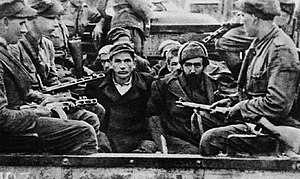
Back عملية فيستولا Arabic Аперацыя «Вісла» Byelorussian Operació Vístula Catalan Operace Visla Czech Aktion Weichsel German Επιχείρηση Βιστούλας Greek Operación Vístula Spanish Opération Vistule French Operazione Vistola Italian ヴィスワ作戦 Japanese
| Operation Vistula | |||
|---|---|---|---|
 UPA members caught by soldiers of the Polish Army | |||
| Date | 28 April – 31 July 1947 | ||
| Location | |||
| Caused by | UPA massacres of Poles, Communist policy of ethnic homogenization and the killing of Karol Świerczewski[1] | ||
| Resulted in | Complete Liquidation of the UPA on the territories of the Polish People's Republic | ||
| Parties | |||
| Lead figures | |||
lack of a unified commander | |||
| Units involved | |||
| Casualties and losses | |||
| Deportation of 141,000 civilians to the Recovered Territories 1135 UPA Soldiers Killed | |||
Operation Vistula (Polish: Akcja Wisła; Ukrainian: Опера́ція «Ві́сла») was the codename for the 1947 forced resettlement of close to 150,000 Ukrainians and Carpatho-Rusyns (Boykos and Lemkos) from the south-eastern provinces of post-war Poland, to the Recovered Territories in the west of the country. The action was carried out by the Soviet-installed Polish communist authorities to remove material support to the Ukrainian Insurgent Army.[2][3] The Ukrainian Insurgent Army continued its guerilla activities until 1947 in Subcarpathian and Lublin Voivodeships with no hope for any peaceful resolution; Operation Vistula brought an end to the hostilities.[4]
In a period of three months beginning on 28 April 1947 and with Soviet approval and aid about 141,000 civilians residing around Bieszczady and Low Beskids were forcibly resettled to former German territories, ceded to Poland at the Yalta Conference at the end of World War II.[4][5] The operation was named after the Vistula River, Wisła in Polish; some Polish and Ukrainian politicians as well as historians condemned the operation following the 1989 fall of communism in Eastern Europe and described it as ethnic cleansing.[6][7] Others argued that no other means of stopping the violence existed since partisans used to regroup outside Polish borders.[4]
At the same time the Soviet Union carried out a parallel action, Operation West, in the Ukrainian SSR. Although both operations were coordinated from Moscow, there was a difference their in results.[4] Operation West was conducted in West Ukraine by the Soviet NKVD and targeted the families of suspected UPA members. Over 114,000 individuals, mostly women and children, were deported to the Kazakh SSR and Siberia and forced into extreme poverty.[4] Of the 19,000 adult males deported by the NKVD, most were sent to coal mines and stone quarries in the north. None of the people deported by the NKVD received any farms or empty homes to live in.[4]
- ^ Motyka, Grzegorz (2011). Od rzezi wołyńskiej do akcji "Wisła". Konflikt polsko-ukraiński 1943–1947. Wydawnictwo Literackie. p. 447. ISBN 978-8-30-804576-3.Jabłoński, Janusz (2011-03-01). "Rozmowa z Grzegorzem Motyką, autorem książki". Gazeta Olsztyńska. Archived from the original on 2016-09-17. Retrieved 2016-09-07.
Obejmuje on swoim zasięgiem lata 1943–1947 i takie wydarzenia jak ludobójcze czystki etniczne dokonane przez Ukraińską Powstańczą Armię na Wołyniu i w Galicji Wschodniej (popularnie zwane rzezią wołyńską), ale też wysiedlenia ludności ukraińskiej w czasie akcji "Wisła". Warto dodać, że mówimy o jednym z najkrwawszych polskich epizodów II wojny światowej – w wyniku działań UPA śmierć poniosło około 100 tysięcy Polaków. (Grzegorz Motyka)
- ^ "Akcja "Wisła" (Wschód) przeciw UPA". Twoje Bieszczady. Retrieved 20 June 2015.
- ^ Eugeniusz Misiło (Євген Місило), Wydział Polityczno-Wychowawczy 7 DP. "Akcja Wisła". Przebieg i statystyki wysiedleń (Introductory notes and tables of data per each voivodeship with index of reference books). Sources: A. B. Szcześniak, W. Z. Szota, Droga do nikąd. Działalność organizacji ukraińskich nacjonalistów i jej likwidacja w Polsce, MON, Warsaw 1973, 433 pages; G. Motyka, Łemkowie i Bojkowie, and Tak było w Bieszczadach, Biuletyn Instytutu Pamięci Narodowej, nr 8-9/2001; Andrzej Kaczyński, U nas tu, u nas tam, Rzeczpospolita, nr 106, 08.05.1997. Archived from the original on January 28, 2006. Retrieved 12 July 2015.
{{cite web}}: CS1 maint: numeric names: authors list (link) - ^ a b c d e f Dr Zbigniew Palski (30 May 2008). "Operacja Wisła: komunistyczna akcja represyjna, czy obrona konieczna Rzeczypospolitej? (Operation Vistula: communist repressions, or the necessary defense of the new Polish Republic?)". Dodatek Historyczny IPN Nr. 5/2008 (12). Nasz Dziennik, Institute of National Remembrance. Retrieved 21 June 2018.
- ^ The Euromosaic notes on the Ukrainian in Poland. European Commission, October 2006. Wayback Machine.
- ^ Timothy Snyder, To Resolve the Ukrainian Question Once and for All: The Ethnic Cleansing of Ukrainians in Poland, 1943-1947. Journal of Cold War Studies, Spring 1999.
- ^ Bohdan S. Kordan (1997), "Making Borders Stick: Population Transfer and Resettlement in the Trans-Curzon Territories, 1944–1949". International Migration Review Vol. 31, No. 3., pp. 704-720 (in) Galicia: A Multicultured Land.
© MMXXIII Rich X Search. We shall prevail. All rights reserved. Rich X Search